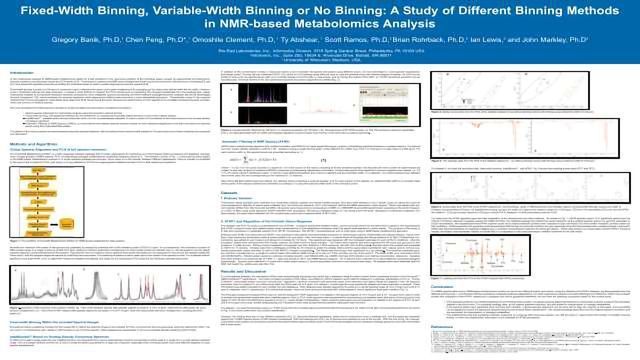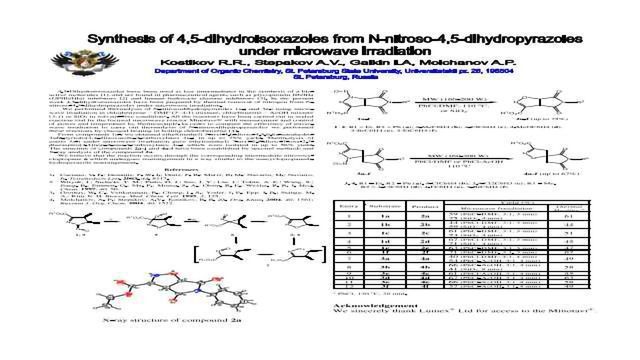Latest Posters

Poster
Fixed-Width Binning, Variable-Width Binning or No Binning: A Study of Different Binning Methods in NMR-based Metabolomics Analysis
In the multivariate analysis of NMR-based metabolomics data, small variations in the resonance position of the individual peaks caused by experimental and instrument induced variations can adversely impact the PCA results. Techniques to address the NMR peak misalignment issue include the commonly used binning or bucketing, and the more advanced algorithms that aim at shifting the individual peaks to reach a better alignment across the spectra.

Poster
Toward Diagnosis of Diabetes by NMR and Mulitvariate Analysis: Study of 1H NMR Spectra of Human Serum in an Integrated Working Environment
In order to improve the efficiency of NMR-based metabolomics studies, we have developed KnowItAll® Informatics System, Metabolomics Edition as a consistent and integrated software environment that covers the entire process from processing raw NMR data —to multivariate analysis—to biomarker identification. Using two datasets of 1H NMR spectra of mouse urine and human serum, we demonstrate the high efficiency of this integrated workflow for metabolomics data analysis.

Poster
Clinical Validation of a Protein Microarry Assay for Diagnostics of Autoimmune Disease
We have developed an autoantigen microarray that will allow laboratories to measure the presence of autoantibobies associated with different collagenois and vasculitis-related autoimmune diseases for a single serum sample.

Poster
Gene Experssion-based Prediction and Mechanistic Assessment of Non-Genotoxic Chemical-Induced Hepatocarcinogenicity
To facilitate both prediction and mechanism-based assessment of human cancer risk, a liver gene expression signature was derived from short term experiments in the rat to predict non-genotoxic hepatocarcinogenicity. The signature was shown to classify 47 independent chemicals with 85% accuracy, much greater than other putative early biomarkers.

Poster
Synthesis of 4,5-dihydroisoxazoles from N-nitroso-4,5 dihydropyrazoles under Microwave Irradiation
4,5-Dihydroisoxazoles have been used as key intermediates in the synthesis of a bioactive molecules and are found in pharmaceutical agents such as glycoprotein IIb/IIIa (GPIIb/IIIa) inhibitors and human leukocyte elastase inhibitors. In the present work 4,5-dihydroisoxazoles have been prepared by thermal removal of nitrogen from N-nitroso-4,5-dihydropyrazoles under microwave irradiation.

Poster
High-Throughput RNAi by Reverse Transfection with low siRNA Concentrations
The use of short interfering RNA (siRNA) for knockdown of gene expression has become a powerful tool in molecular and cell biology. Some applications require the use of low siRNA concentrations (less than 5 nM), for example, to decrease the possibility of nonspecific effects. We present data from experiments carried out using a new transfection reagent, HiPerFect Transfection Reagent, which allows efficient gene knockdown with less than 5 nM siRNA.

Poster
Effective Fishing of Characteristic Proteome Fractions and Identification of Biomarkers Therein: Application of VisualCockpit to Multidimensional Chromatogram and MS Data
Characteristic 2D fractions are rapidly identified among thousands using interactive visualization, filtering and data mining with VisualCockpit. Biomarker candidates are found therein after identifying proteins from sequence tags. VisualCockpit correlates their concentrations, reflected by normalized MS peptide peak height sum, enzyme activity and immunoreactivity, to donor conditions.

Poster
Simplifying the Flow of Drug Discovery Data
Regardless of research disciplines, scientists need to easily reach the information pertinent to their research. Ideally this data access is easy. Researchers also need the ability to ‘move the data around’ to gain a better view or different perspective. This data manipulation needs to be straightforward. Incorporating the varying views and information required by different scientific disciplines is a considerable challenge.

Poster
Identification of Chemokines and Cytokines Involved in the Migration of MSC to Bone Marrow as Well as to Damaged Tissues
Recent in vivo studies have demonstrated that transplanted MSC in mice were able to migrate into various tissues including lung, brain, bone marrow, heart and many others. Nevertheless, mechanisms responsible for the MSC migration remain unclear.

Poster
Combined Immune Parameters and X-ray data in Early Prediction of Anti-Tuberculosis Chemotherapy Response
20 tuberculosis (12 slow-responders and 8 fast responders) patients were treated with directly observed short course anti-tuberculosis chemotherapy. Chest X-ray was performed. sICAM-1 and suPAR were measured in serum by ELISA, TNFRs using the luminex technology. General discrimination analysis on selected analytes gave, 91.66% and 87,50% correctly classify fast responders and slow responder respectively. The support vector machine analysis gave 100% correct classification.
Advertisement



